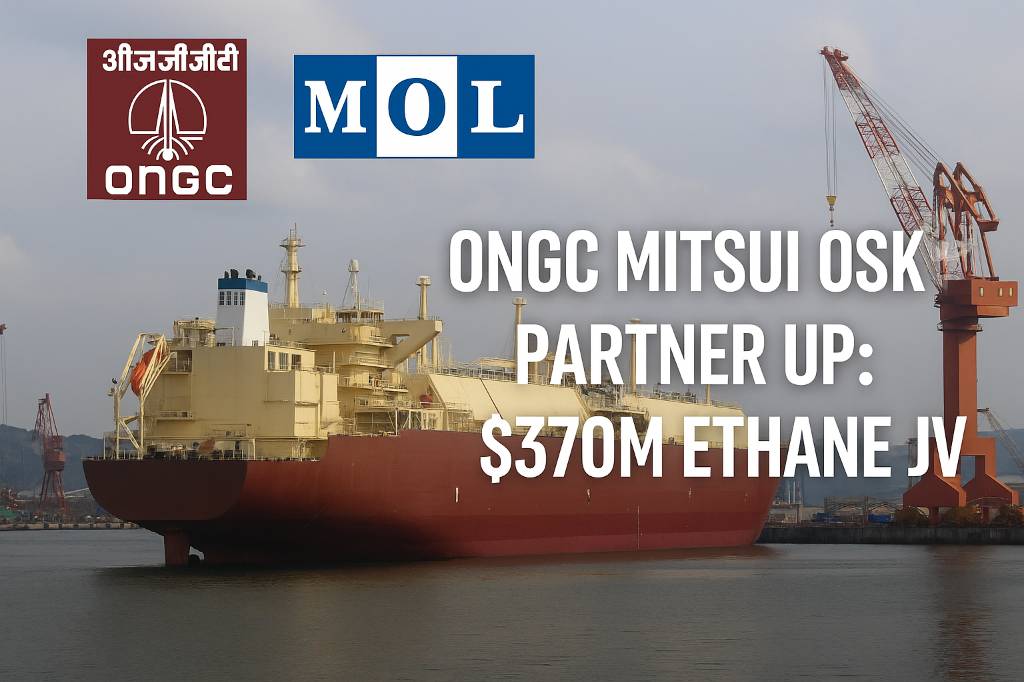
ONGC Mitsui OSK Partner Up to Launch Mega Ethane Carrier JV
- Key Highlights – ONGC Mitsui OSK Partner Up
- What the ONGC Mitsui OSK Partner Up Agreement Covers
- Why the ONGC Mitsui OSK Partner Up Matters
- Strengthening India’s Petrochemical Supply Chain
- Cost Efficiency and Strategic Ownership
- Aligning with India’s Energy Security Goals
- Technical Specs of the VLECs in the ONGC Mitsui OSK Partner Up JV
- Timeline & Operational Impact
- Strategic Benefits from ONGC to OPaL via Mitsui OSK JV
- Enhanced Feedstock Security
- Synergies with OPaL Operations
- Cost Effectiveness & Control Over Supply Chain
- Background: ONGC’s Upstream & Petrochemical Expansion
- Mitsui OSK Lines: A Strategic Shipping Ally
- Economic & Environmental Edge from ONGC Mitsui OSK Partner Up
- Expert Commentary
- Conclusion
In a significant development for India’s petrochemical and shipping sectors, state owned Oil and Natural Gas Corporation Ltd (ONGC) has partnered with Japan’s Mitsui OSK Lines (MOL) to form a joint venture. This ONGC Mitsui OSK partner up initiative aims to build and operate two Very Large Ethane Carriers (VLECs) to bolster ONGC Petro Additions Ltd (OPaL) with ethane feedstock. The collaboration is expected to streamline ethane imports, strengthen OPaL’s operations, and highlight India’s growing energy ambitions.
Key Highlights – ONGC Mitsui OSK Partner Up
Joint Venture Formation: ONGC and Mitsui OSK Lines have signed a Heads of Agreement to establish a JV company for building and operating two VLECs.
Investment Scale: The project involves an estimated investment of US $370 million, as two carriers will be constructed.
Equity Structure: ONGC will hold a minimum 26% stake in the joint venture, with the option to increase it to 50%, while Mitsui OSK Lines retains the majority stake.
Ethane Volume: OPaL plans to secure about 800 ktpa (kilotonnes per annum) of ethane feedstock for its Dahej petrochemical facility, scheduled to begin in 2028.
What the ONGC Mitsui OSK Partner Up Agreement Covers
1. Structure of the Agreement – The ONGC Mitsui OSK partner up MoU is a Heads of Agreement (HoA), formally expressing intent to cooperate on constructing the vessels. Final JV terms await board approvals on both ends.
2. Purpose of the Ethane Carriers – The primary aim is to supply ethane to OPaL’s dual-feed cracker facility in Dahej. These VLECs specialized for long haul liquefied ethane transport will support OPaL’s plant, which is transitioning from naphtha to a combination of naphtha & ethane feedstock.
Why the ONGC Mitsui OSK Partner Up Matters
Strengthening India’s Petrochemical Supply Chain
Launching two state of the art VLECs ensures a robust and dedicated source of ethane, reducing interruptions in raw material supply cards for OPaL’s processing operations.
Cost Efficiency and Strategic Ownership
With ONGC holding a significant equity share, the JV allows emissions and fuel transport costs to be optimized, while Mitsui OSK brings vessel operation expertise and economies of scale.
Aligning with India’s Energy Security Goals
The project aligns with India’s broader ambitions to secure reliable feedstocks, minimize import risks, and add value through downstream petrochemicals crucial for achieving energy independence.
Technical Specs of the VLECs in the ONGC Mitsui OSK Partner Up JV
Capacity: Each VLEC can carry around 98,000–150,000 m³ of liquefied ethane, depending on final shipyard specifications.
Construction Value: Around US $185 million per carrier based on industry estimates.
Build Location: The JV entity is expected to select an international shipyard via competitive bidding for construction.
Timeline & Operational Impact
Final Agreement & Approval: Boards of both ONGC and MOL are reviewing the terms.
Construction Phase: Competitive shipyard selection expected soon.
Delivery & Commencement: The vessels are anticipated to start shipping by May 2028 to coincide with OPaL’s new cracker plant.
Strategic Benefits from ONGC to OPaL via Mitsui OSK JV
Enhanced Feedstock Security
The JV is crucial in replacing Qatar LNG derived feedstock, which excludes ethane under a newer “lean LNG” contract from May 2028 . The new carriers ensure uninterrupted ethane supply for OPaL’s operations.
Synergies with OPaL Operations
Built in Dahej near Mundra and Jamnagar, OPaL’s cracker capacity will be optimized, reducing raw material scarcity risk and production downtime.
Cost Effectiveness & Control Over Supply Chain
The JV helps ONGC hedge against future price volatility and shipping charges, offering downstream cost predictability with more operational transparency.
Background: ONGC’s Upstream & Petrochemical Expansion
ONGC has significantly invested in OPaL, notably a C2/C3 extraction plant (~₹1,500 crore) to recover ethane/propane from LNG, and strengthened its stake in OPaL. The ONGC Mitsui OSK partner up move complements these efforts, ensuring long‑term feedstock security.
Mitsui OSK Lines: A Strategic Shipping Ally
As of mid 2025, MOL was the world’s second-largest LNG carrier fleet, with 97 carriers in operation, and a total fleet of 797 vessels.
The shipping giant already operates multiple LNG and crude carriers for Indian PSUs (BPCL, SCI). This JV marks its debut in large scale ethane transport to India.
Economic & Environmental Edge from ONGC Mitsui OSK Partner Up
Financial Upside
- JV Investment: $370 million into real assets and shipping capacity.
- Operational Leverage: Equity stake offers ONGC downstream margins control.
Environmental Consideration
VLECs, while consuming bunker fuel, reduce CO₂ impact per ton of transported feedstock by optimized scale efficiency.
Expert Commentary
Market analysts view the move as a strategic “win-win” partnership:
- ONGC gets commodity price control;
- MOL gains entry into India’s future ethane logistics segment;
- OPaL secures a stable, long‑term feedstock route;
- India builds infrastructure toward petrochemical self reliance.
Conclusion
The ONGC Mitsui OSK partner up agreement marks a watershed moment for Indian downstream energy security. The collaboration mirrors global standards in logistics, integration, and foresight ushering in cost optimized, reliable feedstock deliveries for OPaL’s growth. It’s a strategic expansion that will likely shape the petrochemical landscape through 2028 and beyond.
Stay Connected with The News Drill for more news updates.
Have insights or tips about India’s energy and shipping sector?
Email us at: contact@thenewsdrill.com
Submit a story: editor@thenewsdrill.com or visit our Contributor Page.
Follow us for more updates on India’s evolving energy sector.







